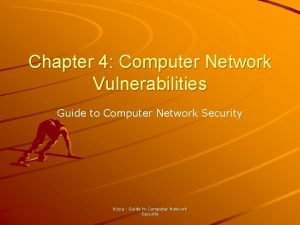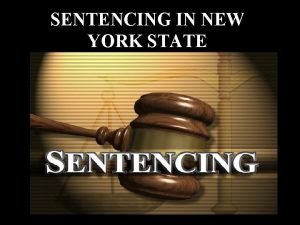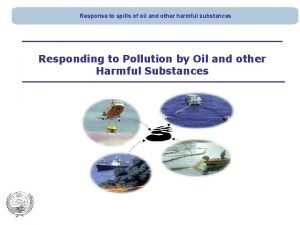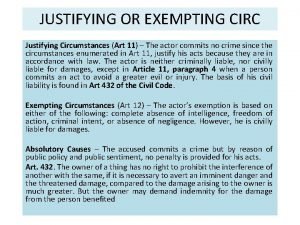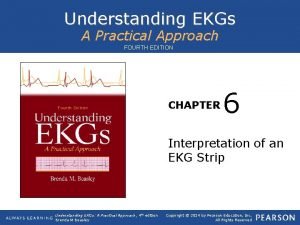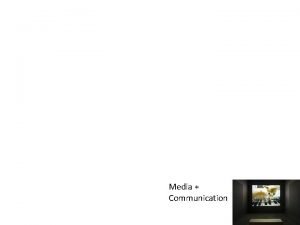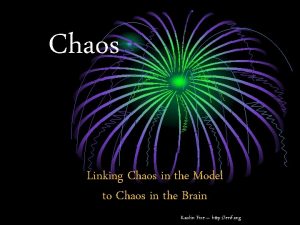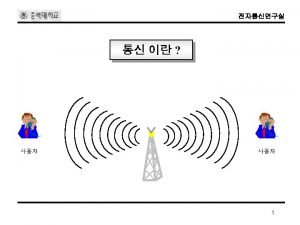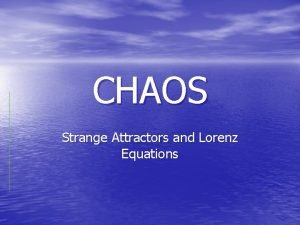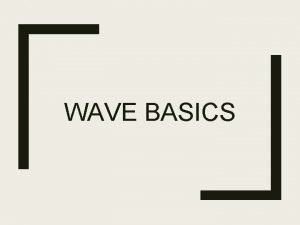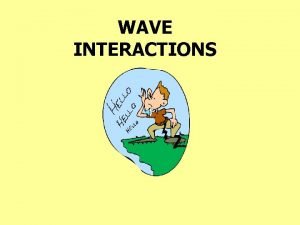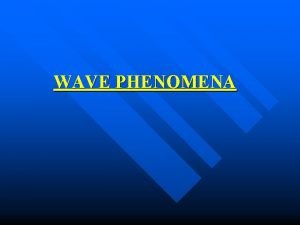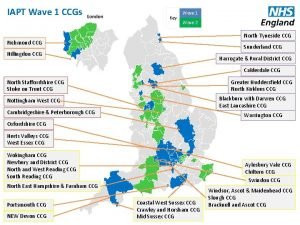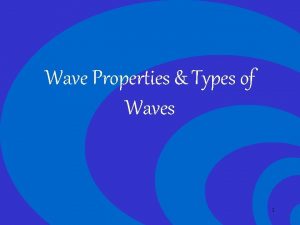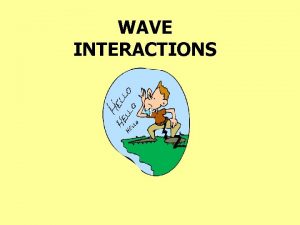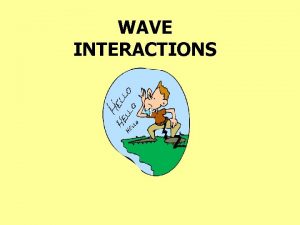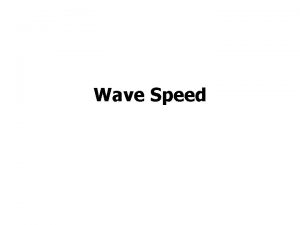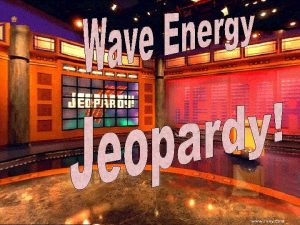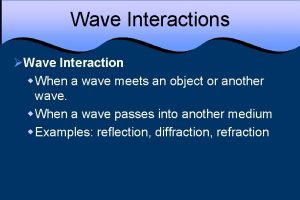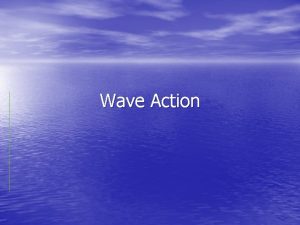A Wave Chaos Approach to Understanding and Mitigating




















- Slides: 20

A Wave Chaos Approach to Understanding and Mitigating Directed Energy Effects Steven Anlage, Thomas Antonsen, Edward Ott ONR App. El @ 1

The Maryland Wave Chaos Group Graduate Students Ming-Jer Lee Harita Tenneti Trystan Koch Undergraduate Student Christopher Bennett Jen-Hao Yeh James Hart Now at Lincoln Labs Biniyam Taddese Post-Doc Dr. Gabriele Gradoni 2010 URSI Young Scientist Award Tom Antonsen Steve Anlage Ed Ott NRL Collaborators: Tim Andreadis, Lou Pecora, Hai Tran, Sun Hong, Zach Drikas, Jesus Gil ONR App. El @ Funding: AFOSR MURI 2001; AFOSR; ONR MURI 2007; ONR App. El 2

A Wave Chaos approach to understanding / quantifying DE Effects in electronics The model works for ‘ray-chaotic’ enclosures Two incident rays with slightly different initial directions have rapidly diverging trajectories Embrace CHAOS as the central organizing principle! Many electronic enclosures display ray chaos Computer enclosures Aircraft cockpits Ship compartments Offices etc. ONR App. El @ 3

The Random Coupling Model A quantitative model of statistical and systematic aspects of HPM effects in enclosures Statistical aspects: The underlying classical chaos means that the wave properties are ‘universal’ and governed by Random Matrix Theory (RMT) ► The statistics of all wave properties (resonant freqs. , standing wave patterns, Z, Y, S, etc. ) are UNIVERSAL and governed by a single loss parameter: The non-universal aspects are captured by the radiation impedance Zrad of the coupling ‘ports’ Zrad of the ports can be determined by a number of techniques, both experimental and theoretical ONR App. El @ RCM Web Site: http: //www. cnam. umd. edu/anlage/RCM/index. htm 4

Effect of Direct Ray Paths Original Random Coupling Model (RCM) - RF energy is randomized on entering cavity - Only radiation impedance of ports, cavity volume and average Q are important In some geometries, or in narrow frequency bands specifics of internal geometry are important Systematic aspects of HPM Effects Inclusion of ‘Short Orbits’ in the RCM Modified Random Coupling Model - J. Hart et al. , PHYSICAL REVIEW E 80, 041109 (2009) - Allows for systematic improvement by inclusion of geometric details if known - Can be used in conjunction with measured data ONR App. El @ 5

Extensions of The Random Coupling Model Theory work Systematic aspects of HPM Effects funded by AFOSR Inclusion of ‘Short Orbits’ in the RCM ↔ x is a complex matrix with universal fluctuations governed by the loss parameter a = df 3 d. B/Df ↔ ↔ ↔ ↔↔ Survival probability in the ensemble ONR App. El @ Uniform attenuation James Hart, T. Antonsen, E. Ott, Phys. Rev. E 80, 041109 (2009) 6

Nonuniversal Properties Captured by the Extended RCM Empty Cavity Data and Theory smoothed with the same 125 -cm (240 MHz window) low-pass filter Experimental work funded by AFOSR, and now ONR/App. El ONR App. El @ Theory includes all orbits to 200 cm length J. -H. Yeh, et al. , Phys. Rev. E 81, 025201(R) (2010); J. -H. Yeh, et al. , ar. Xiv: 1006. 3040 7

Extensions of The Random Coupling Model Realistic systems consist of many coupled enclosures Can the RCM be extended to handle these situations? J. P. Parmentier (ONERA) ONR App. El @ 8

Extending the RCM to the case of Coupled Cavities Cavity 1 Approximations: high loss, weak transmission Cavity 2 Fluctuations in transmission through cavity 1 Mean properties of cavity 2 The statistics of coupling are dominated by the statistics of transmission through the first cavity, scaled by the mean impedance of the next cavity Generalize to an arbitrary cascade of enclosures and treat junction topology ONR App. El @ 9

Extending the RCM to the case of Coupled Cavities Future Work: Consider networks of coupled cavities Graph topology ONR App. El @ 10

The Statistics of Tunneling between Enclosures Work in collaboration with Lou Pecora @ NRL In some cases, two enclosures will be coupled by structures beyond cutoff Examples include metal ducts at frequencies below cutoff, intermediate rooms/compartments that are below resonance Enclosure 1 Barrier Can we use what we know about chaotic eigenfunctions to solve this problem? Does it make a difference if the enclosures are regular or chaotic? Enclosure 2 Regular Enclosure case ONR App. El @ Barrier Enclosure 1 Enclosure 2 Ray Chaotic Enclosure case 11

The Statistics of Tunneling between Enclosures: The 1 D Case Energy splitting Dk 2 is proportional to the tunneling rate through the barrier ONR App. El @ 12

Splitting Fluctuations versus Energy Numerical simulations by Lou Pecora (NRL) ONR App. El @ These splittings, and their fluctuations, are predictable in the chaotic case 13

Results of Wave Chaos Theory The theory uses the random plane wave hypothesis to calculate the tunneling rate Sliding average of mean splitting Surprisingly, all three agree quite closely… Sliding average of splitting fluctuations Wave chaos theory in agreement with simulations Black lines (Data) – simulations by Lou Pecora (NRL) ONR App. El @ 14

An Experiment to Test the Wave Chaos Tunneling Theory Barrier Infinite Waveguide Ray-Chaotic Enclosure The tunneling escape rate will vary from mode to mode, giving fluctuations in the quality factor of the modes. The mean and fluctuations of the 1/Q with k 2 should follow the wave chaos theory predictions ONR App. El @ 15

New Research and Transfer of RCM Knowledge Base to Naval Research Lab We are collaborating with the group of Tim Andreadis to test the RCM is more realistic scenarios, and to transfer our knowledge / know-how to Do. D Experimental tests of the RCM in 3 D enclosures Hai Tran and Zach Drikas Radiation Impedance Measurement ONR App. El @ New Antenna Configuration 16

The Electromagnetic Chaotic Time-Reversal Sensor Work funded by ONR MURI 2007 60 ns pulse with 7 GHz (λ~4 cm) center frequency. Transmitted Sona Anlage et al. Acta Physica Polonica A 112, 569 (2007) ONR App. El @ 17

ELECTROMAGNETIC Chaotic Time-Reversal Sensor: - Injection of time reversed Sona Sensors based on time-reversed pulse reconstruction: B. T. Taddese, et al. , Appl. Phys. Lett. 95, 114103 (2009) B. T. Taddese, et al. , ar. Xiv: 1008. 2409 ONR App. El @ 18

Electromagnetic Time-Reversal of Enclosure with Aperture Sun Hong, Zach Drikas, Hai Tran, Jesus Gil, Tim Andreadis, NRL Step 1: Port 2 Port 1 5 ns Short Monopole Inside ONR App. El @ 19

Conclusions The Random Coupling Model is being extended and generalized in new ways Short Orbits Connected Enclosures Electrically Large Antennas Theory and Experiment work in parallel, and stimulate each other NRL Collaboration has resulted in: New experiments and new applications for the RCM and time-reversed EM Extension of the RCM Transfer of know-how to Do. D Future Work: Experimental test of tunneling fluctuations Theory of multiple connected and networked enclosures Modeling and experiments of fading statistics IC Post-Doc grant: Nonlinear time-reversed electromagnetics DURIP proposal: System for Investigation of Terahertz Wave Chaos ONR App. El @ 20
 Computer network vulnerabilities
Computer network vulnerabilities Examples of mitigating factors
Examples of mitigating factors Smpep and sopep difference
Smpep and sopep difference Incomplete justifying circumstances
Incomplete justifying circumstances Difference between full wave and half wave rectifier
Difference between full wave and half wave rectifier Transverse and longitudnal waves
Transverse and longitudnal waves Fullwave rectification
Fullwave rectification Earthquake p-wave and s-wave travel time graph
Earthquake p-wave and s-wave travel time graph Mechanical waves and electromagnetic waves venn diagram
Mechanical waves and electromagnetic waves venn diagram Venn diagram mechanical and electromagnetic waves
Venn diagram mechanical and electromagnetic waves Velocity frequency wavelength triangle
Velocity frequency wavelength triangle Sound is a transverse wave true or false
Sound is a transverse wave true or false Carbon dioxide temperature
Carbon dioxide temperature Half full wave rectifier
Half full wave rectifier Full wave rectified sine wave fourier series
Full wave rectified sine wave fourier series Nature of sound wave
Nature of sound wave The nature of waves chapter 10 section 1
The nature of waves chapter 10 section 1 Half wave symmetric signal
Half wave symmetric signal Understanding ekgs a practical approach
Understanding ekgs a practical approach Culture as a skyscraper
Culture as a skyscraper Virtual circuit and datagram network
Virtual circuit and datagram network
